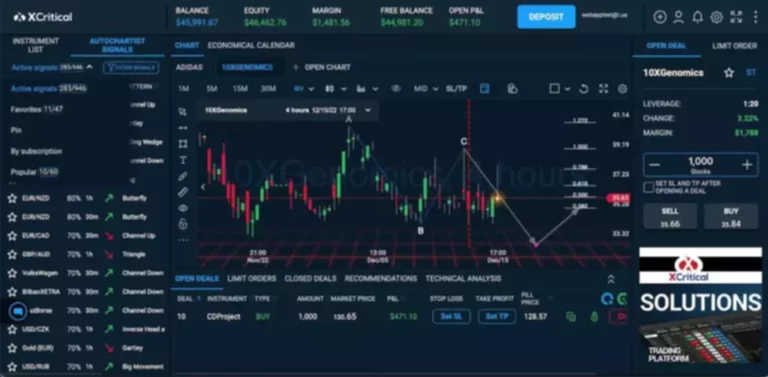Unlocking Hft: High-frequency Buying And Selling’s Impact On Markets
Traders with the fastest execution speeds are generally more worthwhile than these with slower execution speeds. This is as a outcome of HFT permits for quick response to market modifications, giving merchants a aggressive edge. Due to its complexity, huge institutional buyers like hedge funds and funding banks are those who use it essentially the most. By addressing these issues, it is attainable to harness the benefits of HFT whereas minimizing its potential dangers. A balanced strategy that fosters innovation, protects investors, and ensures market stability is important for the long-term health of the financial system.
Mr. Vivek Bajaj has over 18 years of trading experience in equities, choices, currencies, and commodity markets. He is the co-founder of Stockedge and Elearnmarkets and is passionate about https://www.xcritical.com/ knowledge, analytics, and know-how. He serves on various change committees and has performed a significant function within the evolution of India’s derivative market. He has been a speaker at numerous schools and higher establishments, together with IIT and IIMs. High-frequency trading’s main advantages are its ease of use and quick transaction execution.
HFT corporations use state-of-the-art hardware and strong computer systems to analyse monumental quantities of market information immediately. These algorithms spot developments, patterns, and discrepancies in price that can be made money off of. Automated algorithms benefit from even the slightest value differentials by executing trades inside microseconds of detecting a favourable opportunity. Taking advantage of small value variations available within the market is decided by velocity and automation. HFT merchants execute trades at breakneck rates in an attempt to capitalise on these transient chances. Complicated software program packages that analyze market data, identify opportunities, and execute trades automatically.
What Are The Problems With Excessive Frequency Trading?

This means the difference between the shopping for price and the promoting worth of an asset becomes smaller. Narrower spreads translate immediately into lower transaction costs for all market members, together with retail buyers. For occasion, studies confirmed that bid-ask spreads rose by 9% after Canadian authorities imposed fees discouraging HFT in 2012, suggesting a direct correlation between HFT presence and tighter spreads. These methods and strategies allow HFT merchants to remain ahead of the competitors and generate substantial profits in the cryptocurrency market.
The very term “high frequency” instantly refers again to the lightning velocity at which these trades are completed. High-frequency trading (HFT) is algorithmic trading characterised by high-speed commerce execution, a particularly massive number of transactions, and a very short-term investment horizon. HFT leverages particular computer systems to achieve the very best pace of trade execution potential.
The Benefits And Drawbacks Of High-frequency Trading
These firms usually have entry to info and expertise that other traders do not, which gives them an edge. Lastly, excessive frequency trading has been linked to previous market crashes, together with the 2010 Flash Crash. High-Frequency Trading has undeniably revolutionized financial markets, bringing forth a new period of speed, effectivity, and interconnectedness. These advantages translate into decrease transaction costs and improved overall market efficiency for a variety of participants. HFT also serves as a potent catalyst for continuous technological innovation inside the monetary business, pushing the boundaries of computing and communication.

Regulators have fined several HFT corporations for violating rules and fascinating in reckless buying and selling practices. The historical past of high-frequency buying and selling (HFT) is a captivating story that spans over three decades. It all started in 1983 when NASDAQ introduced a purely digital form of trading. High-frequency trading (HFT) has been surrounded by controversy and risk. The high-frequency strategy was first made well-liked by Renaissance Technologies, who use each HFT and quantitative aspects of their trading. As of 2009, total property underneath management for hedge funds with HFT methods had been $141 billion, down about 21% from their peak before the disaster.
- Moreover, the very pace and automation that enable HFT’s advantages also open avenues for classy market manipulation techniques like spoofing, layering, and quote stuffing.
- In order to realize this, HFT corporations use superior laptop algorithms and high-speed data networks that are specifically designed for cryptocurrency trading.
- Excessive frequency merchants’ salaries range from $56,500 (25th percentile) to $105,500 (75th percentile), with the majority earning above $80,000.
Market makers provide a counterbalance to incoming market orders by doing this. These entities are in a position to rapidly execute giant portions of trades due to it. Minimizes latency (time delay) between order submission and execution, crucial for velocity advantage. Specialised hardware optimized for fast information processing and commerce execution. Algorithms can be created to initiate 1000’s of orders and canceling them seconds later, making a momentary spike in price. Taking benefit of such a kind of deception is extensively considered immoral and generally unlawful.
As you delve into the world of cryptocurrency trading, it’s necessary to consider the benefits and drawbacks of High-Frequency Buying And Selling (HFT) in this digital asset space. High-frequency trading remains worthwhile because of its ability to capitalize on small value fluctuations and bid-ask spreads. However, its profitability is very depending on the complexity and effectiveness of the trading algorithms used. By 2010, HFT trades had decreased in execution time to milli- and even microseconds, making it an extremely quick and environment friendly way to commerce.
The speedy trading activity characteristic of HFT has the potential to amplify market volatility, leading to sudden and important price swings. This may end up in increased instability and pose systemic dangers to the monetary system. When quite a few HFT algorithms react uniformly to market alerts, it can create powerful suggestions loops that rapidly speed up value actions, particularly throughout already unstable conditions. The 2010 Flash Crash is a stark example, where HFT’s fast reactions and liquidity withdrawal exacerbated a market plunge. HFT methods are meticulously engineered to repeatedly monitor international market data Smart contract, analyze value actions, and place orders in real-time throughout multiple buying and selling ecosystems.
If an investor bought a low-liquid safety, he won’t be able to promote it shortly. Additionally, market makers can receive an extra fee from the trade for creating liquidity in the market. There is some debate over whether or not excessive frequency trading constitutes manipulation. Some say that HFT firms have an unfair advantage as a end result of they are in a position to see and react to market circumstances quicker than different merchants. Others argue that HFT is not manipulative because all merchants have access to the same info. The actuality is that we don’t know for certain whether HFT is manipulative or not.
High-frequency buying and selling permits main buying and selling entities to execute huge orders very quickly. The notorious Knight Capital software program glitch in 2012 serves as a stark reminder of operational dangers. A software error triggered the then-major HFT agency to by accident buy and promote hundreds of thousands of shares in 150 stocks inside forty five minutes, leading to a staggering $440 million loss and practically bankrupting the corporate. HFT operates under fixed regulatory scrutiny due to persistent concerns about market fairness, potential manipulation, and systemic stability. Ethical dilemmas are widespread, stemming from the uneven enjoying field it creates , accusations of predatory practices , and the tendency of HFT companies to withdraw liquidity during periods of stress. Securities and Exchange Commission (SEC), have actively fined HFT companies for practices deemed to be worth manipulation or fraudulent trading.
Some European countries want to ban high-frequency buying and selling to reduce volatility, finally preventing antagonistic events, such as the 2010 US Flash Crash and the Knight Capital collapse. High-frequency trading stays a controversial exercise and there is hft trading little consensus about it amongst regulators, finance professionals, and students.
Generally a high-frequency dealer will solely make a tiny profit—just a couple of pennies—which offers them the chance to make gains all day long but in addition raises the potential for struggling an enormous loss. HFT companies use a way called “market making,” which provides liquidity by constantly quoting buy and promote costs for particular assets. Regulators and policymakers have a crucial function to play in guaranteeing that HFT operates in a fair and transparent method. The SLP was launched following the collapse of Lehman Brothers in 2008, when liquidity was a significant concern for investors.
Recent Posts
All Categories
- ! Без рубрики
- 1Win Brasil
- 1win Brazil
- 1win India
- 1WIN Official In Russia
- 1win Turkiye
- 1win uzbekistan
- 1winRussia
- 1xbet casino BD
- 1xbet Korea
- 1xbet malaysia
- 1xbet Morocco
- 1xbet russia
- 20bet Deutschland
- 22bet
- 22bet Deutschland
- 888starz bd
- AI News
- alcampoadistancia.es
- ardynband.co.uk
- aviator
- aviator brazil
- Bankobet
- bbrbet colombia
- big-bass-splash-echtgeld-spielen.online
- bizzo casino
- black-hole-kostenlos-spielen.online
- Blog
- book of ra
- canadasirishfest.com – 한국 카지노 사이트 신규 랭킹
- casibom tr
- casino
- casino en ligne fr
- casino online ar
- casinò online it
- Casino Sites Korea
- Casino Sites Rating in South Korea
- casino zonder crucks netherlands
- chime chatbot 1
- ciudadfeminista.cl
- crazy time
- elflaco.es
- eye-of-horus-kostenlos.online
- FinTech
- fishin-frenzy-slot-demo.online
- freshandvintage.fr
- funmbi-omotayo.co.uk
- Gama Casino
- gates-of-olympus-1000-slot.online
- glory-casinos tr
- gullewaard.nl
- Kasyno Online PL
- king johnnie
- Maribet casino TR
- Masalbet
- melomanosmag.cl
- monasteriosantacruz.es
- moneytrain3-kostenlos-spielen.online
- Monobrand
- Mostbet Russia
- mostbet tr
- nakedconcept.es
- noticiasneiva.co
- Offizielle Website von 22Bet in Deutschland
- online casino au
- Pagbet App Download 10
- Pin UP
- pinco
- plinko
- plinko_pl
- Post
- Qizilbilet
- Ramenbet
- razor-shark-slot-kostenlos-spielen.online
- retrotapes-kostenlos-demo.online
- Review
- ricky casino australia
- Slots
- slottica
- Sober living
- sugar rush
- sweet bonanza
- Uncategorized
- verde casino hungary
- Vovan Casino
- Wanabet Bono 341
- Комета Казино
- 한국 카지노 사이트 평가

Thailand

